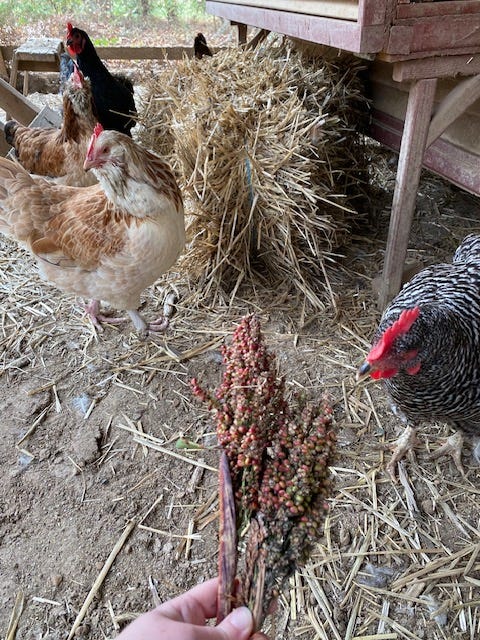5 things I learned from milling and growing my own grains
Last year, for the first time, I milled and baked with grains that I grew.
Last year, for the first time, I milled and baked with grains that I grew. The flavors were better than I expected and growing efforts were minimal. However, last year’s grain garden efforts taught me a few things.
Chicken snack garden de-prioritized. I had planned on making a chicken garden to grow our own flock snacks. After experiencing the volume and harvest requirements in test patches, I’ve decided not to create a dedicated garden for the chickens. They enjoy garden scraps anyway, and they snacked on the inferior grains that weren’t suitable for harvest and storage. They’re not complaining.
Threshing wheat could be easier. I’ve watched many videos on harvesting and threshing wheat at home. There’s one more method I’d like to try (adding a chain to an electric hand drill and threshing the wheat in a bucket), but so far wheat is more labor intensive and less fun to thresh by hand than other grains. I’m absolutely in love with the varieties I’m growing (blue emmer, turkey red winter wheat, Appalachian white) and will continue to grow them and try out more threshing methods. Comment if you recommend any.
Birds love grains too. Wheat grew equally well in my in-ground garden and high tunnel, but the wild birds were more in tune with harvest time in the garden than I was. I wasn’t able to harvest any of the wheat grown in the garden because the birds got it before me, but I did harvest everything I grew in the high tunnel. Now I know to reserve garden space for other grains and keep the wheat in the tunnel.
Sorghum is fun. I think the sorghum stalks topped out at about 12’ tall. They were majestic and added color and depth to the garden and were simple to harvest and dry out. (I grew coral sorghum sourced from the Appalachian Seed Growers Collective.) The wild birds didn’t bother the sorghum one bit, and the chickens enjoyed any inferior seed clusters. With high iron and tannins associated with anti-cancer properities, sorghum offers nutritional benefits as a gluten-free grain. I grew a sorghum patch on the south side of the garden last year. Knowing how well and how tall it grows now, I’ll grow it on the north side of the garden this year. If I’m not too burnt out at the end of the growing season, I’d love to try pressing syrup (aka make molasses).
More sesame for me. Sesame seeds are rooted in my childhood memories. Every week my parents would pick up Italian bread from a local bakery and it was covered in sesame seeds. I hated them. I would scrape off every seed and the bread would still have the (at-the-time) awful sesame flavor. I would do the same at restaurants whenever sesame seeds showed up on buns, crackers, or breadsticks. At some point as our taste buds change every 7 years, the flavor stopped bothering me. I also discovered tahini. My inaugural sesame seed plant last year produced plenty of seed pods. They’re simple to harvest and no birds or pests bothered the plants in the garden. In my earlier post about making your own plant guilds, I shared my sesame-sorghum-strawberry guild and I plan to do that again this year. Sesame seeds add fiber and phytosterols (linked to to lowering cholesterol).
Some of the links in the next section are affiliate links. I make a small commission from purchases made through these links, at no cost to you. I share products that I know and use.
As of this writing, the NutriMill grain mill I use is currently sold out, but their high-speed Classic Grain Mill is in stock. If you’re curious about the brand and how they source materials for the mills, I highly recommend listening to an interview with NutriMill’s president on the Homesteaders of America Podcast, Episode 35.






